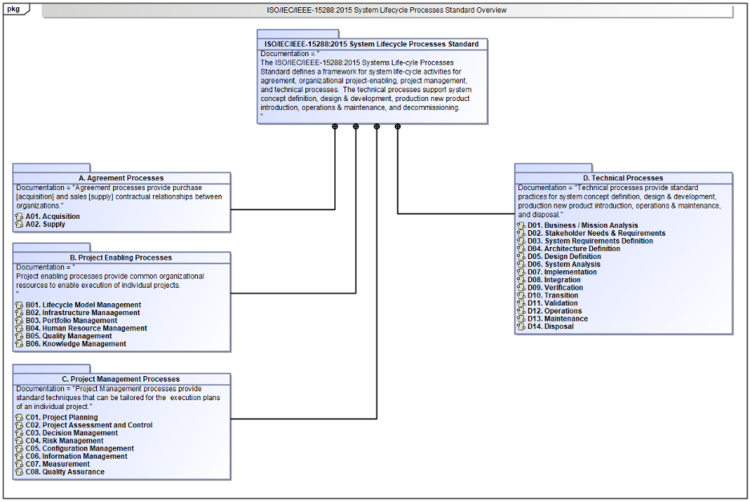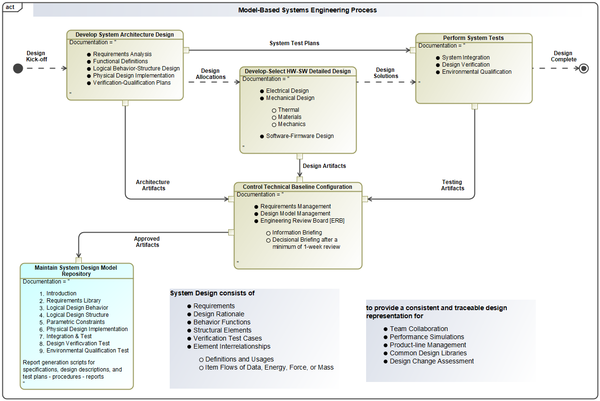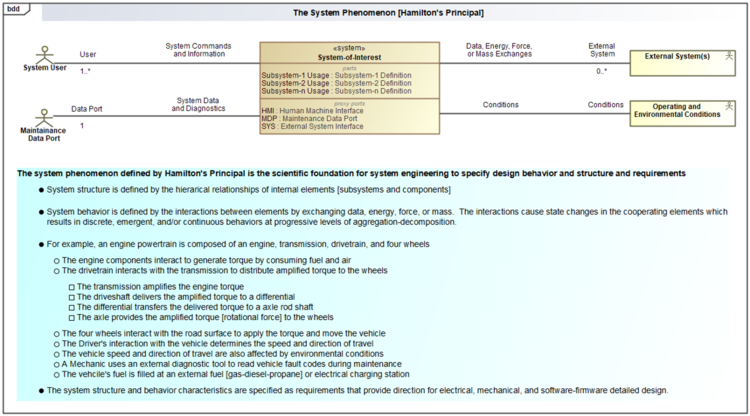Difference between revisions of "Systems Engineering and Management"
| Line 89: | Line 89: | ||
INCOSE. 2015. ''Systems Engineering Handbook: A Guide for System Life Cycle Processes and Activities'', version 4.0. Hoboken, NJ, USA: John Wiley and Sons, Inc, ISBN: 978-1-118-99940-0. | INCOSE. 2015. ''Systems Engineering Handbook: A Guide for System Life Cycle Processes and Activities'', version 4.0. Hoboken, NJ, USA: John Wiley and Sons, Inc, ISBN: 978-1-118-99940-0. | ||
| + | |||
| + | ISO. 2007. ''Systems Engineering and Design.'' Geneva, Switzerland: International Organization for Standardization (ISO). ISO 10303-AP233. | ||
ISO/IEC/IEEE. 2015. ''Systems and Software Engineering -- System Life Cycle Processes''. Geneva, Switzerland: International Organisation for Standardisation / International Electrotechnical Commissions / Institute for Electrical and Electronics Engineers. ISO/IEC/IEEE 15288:2015. | ISO/IEC/IEEE. 2015. ''Systems and Software Engineering -- System Life Cycle Processes''. Geneva, Switzerland: International Organisation for Standardisation / International Electrotechnical Commissions / Institute for Electrical and Electronics Engineers. ISO/IEC/IEEE 15288:2015. | ||
| − | |||
| − | |||
Oliver, D., T. Kelliher, and J. Keegan. 1997. ''Engineering Complex Systems with Models and Objects''. New York, NY, USA: McGraw-Hill. | Oliver, D., T. Kelliher, and J. Keegan. 1997. ''Engineering Complex Systems with Models and Objects''. New York, NY, USA: McGraw-Hill. | ||
| − | |||
OMG Systems Modeling Language [SysML®] Standard – v1.6, November 2019 | OMG Systems Modeling Language [SysML®] Standard – v1.6, November 2019 | ||
| − | + | Roper, W. 2020. ‘’There is No Spoon: The New Digital Acquisition Reality.’’ Arlington, VA: US Space Force, US Air Force, Assistant Secretary of the Air Force. 07 October 2020. https://software.af.mil/wp-content/uploads/2020/10/There-Is-No-Spoon-Digital-Acquisition-7-Oct-2020-digital-version.pdf | |
| − | |||
| − | |||
| − | |||
| − | |||
| − | + | Schindel, B. 2016. “Got Phenomena? Science-Based Disciplines for Emerging Systems Challenges,” International Council on Systems Engineering (INCOSE), 2016 INCOSE International Symposium Proceedings, Edinburgh, Scotland. | |
| − | + | Schindel, B. 2018. “The System Phenomenon, Hamilton’s Principle, and Noether’s Theorem as a Basis for System Science,” International Council on Systems Engineering (INCOSE), 2018 INCOSE International Workshop Proceedings, Torrance, California. | |
| − | + | U.S. DOD. 2018. ‘’Digital Engineering Strategy.’’ Arlington, VA: Office of the Deputy Assistant Secretary of Defense for Systems Engineering. June 2018. | |
| − | + | Wasson, C. 2006. System Analysis, Design, and Development – Concepts, Principles, and Practices.’’ Hoboken, NJ: John Wiley & Sons. | |
===Primary References=== | ===Primary References=== | ||
Revision as of 19:28, 20 May 2022
Lead Authors: Jeffrey Carter and Caitlyn Singham
Part 3: Systems Engineering and Management (SE&M) materials provide system lifecycle best practices for creating and executing interdisciplinary processes to ensure that customer needs are satisfied with a technical performance, schedule, and cost compliant solution. The figure below depicts the context of SE&M processes and practices guidance within the SEBoK. The SE&M materials are currently being updated to provide system design practitioners with Model-Based Systems Engineering [MBSE] implementation guidance employing the Systems Modeling Language (SysML®).

Knowledge Areas in Part 3
Each part of the SEBoK is divided into knowledge areas (KAs), which are groupings of information with a related theme. Part 3 contains the following themes:
- Systems Engineering STEM Overview
- Model-Based Systems Engineering (MBSE)
- Systems Lifecycle Approaches
- System Lifecycle Models
- Systems Engineering Management
- Business and Mission Analysis
- Stakeholder Needs Definition
- System Architecture Definition
- Detailed Design Definition
- System Analysis
- System Realization
- System Implementation
- System Integration
- System Verification
- System Transition
- System Validation
- System Operation
- System Maintenance
- Logistics
- Service Life Management
- Systems Engineering Standards
See the article Matrix of Implementation Examples for a mapping of case studies and vignettes included in Part 7 to topics covered in Part 3.
The SE&M articles depicted within an outline of the Part 3 materials with the status of model-based guidance updates can be found in the SEBoK Table of Contents. The SE&M processes and practices provide tailorable guidance for an engineering organization to satisfy strategic business goals and individual project objectives including:
- How engineering conducts system development
- The purpose of each engineering artifact generated
- How systems are integrated, and requirements verified
- How new product designs are transitioned to production
- How the resulting system is employed and sustained to satisfy customer needs
Systems Engineering & Management Overview
Systems engineering (SE) conducts behavioral and structural design analyses applying interdisciplinary processes and practices to integrate System, Electrical, Mechanical, Software, and Specialty Engineering (EE, ME, SW, and SP) disciplines. The design objective is to develop a holistic technical solution that satisfies specific customer application criteria. SE has traditionally applied intuitive domain-specific practices emphasizing processes and procedures with good writing skills to manually organize information in a disparate collection of documents. The traditional SE deliverables are textual system requirement specifications, analysis reports, system design descriptions and interface specifications.
Figure 2 depicts the “Digital Trinity” of innovative design practices to transform traditional system development including the adoption of Agile System / Software Development, a Modular Open Systems Approach [MOSA], and Digital Engineering.
The governing principle of Digital Engineering is development of system design models with high-fidelity simulation capabilities to realistically emulate systems in virtual computing environments. The design model includes functional, logical, and physical system design representations with high-fidelity simulation capabilities that are integrated with EE, ME, SW, and SP design disciplines for system functional and performance assessments. The integrated simulations provide a digital twin with digital threads of critical system characteristics to evaluate design alternatives in virtual computing environments to discover and resolve design defects before the expense of producing physical prototypes.
- Digital threads are analytical frameworks providing end-to-end system simulation representations to evaluate logical operations and key performance parameters in virtual environments by exchanging information between different modeling tools across the lifecycle.
- Digital twins are authoritative representations of physical systems including the digital thread end-to-end connections with all the data, models, and infrastructure needed to create and optimize a system’s lifecycle digitally. Digital twins enable project team collaboration, system simulation functional performance assessments, design change impact evaluations, and product-line management reuse libraries
The digital engineering transformation includes the adoption of Model-Based Systems Engineering [MBSE] as an alternative approach to traditional document-based systems engineering methods. INCOSE defines MBSE as the formalized application of graphical modeling with specific semantic definitions throughout the system lifecycle. MBSE includes the creation, development, and utilization of digital design models with domain product-specific [e.g., aerospace, automobile, software, consumer, …] analyses to define system requirements and behavior/structure characteristics.
The design model provides a Single Source of Truth [SSoT] for the system technical baseline enabling project team and stakeholder collaboration. The design model contains diagrams and meta-data depicted with a graphical modeling language [e.g., Systems Modeling Language [SysML®]. The modeling language has precise semantic definitions for depicting systems design characteristics. There are several commercially available tools compliant with the Object Management Group’s [OMG’s] industry SysML® standard.
MBSE enhances the ability to capture, analyze, share, and manage authoritative information associated with the complete specification of a product compared to traditional document-based approaches. MBSE provides the capability to consolidate information in an accessible, centralized source, enabling partial or complete automation of many systems engineering processes, and facilitating interactive representation of system components and behaviors.
The legacy SE&M materials are all impacted by the adoption of MBSE practices, and the SEBoK is updating its materials accordingly to reflect best practices and principles in an integrated model-based engineering environment. The updated materials to specify system behavior and structure characteristics with traceability to the associated requirements are organized in accordance with the ISO/IEC/IEEE-15288:2015 Systems Lifecycle Processes Standard shown in the figure below.
Figure 4 depicts a generic example of the model-based system design process. The approach is consistent with INCOSE’s Systems Engineering Handbook guidance with the addition of a system design model repository to manage the project technical baseline. The MBSE design process is independent of any specific design methodology (e.g., structured analysis, object orientated, etc.) employed. Each design model element has a single definition with multiple instantiations on various diagrams depicting system structure and behavior characteristics including traceability to the associated requirements. The model-based design process may be tailored for projects dependent on the domain-area, development, and lifecycle approaches.
Product domain-area system design knowledge and expertise are still mandatory with implementation of an MBSE approach, which employs integrated modeling tools instead of legacy drawing tools (e.g., Powerpoint, Visio), textual-based specifications (e.g., DOORS), and engineering analysis reports and design descriptions (Word).
The SE&M model-based system design guidance enables a multi-disciplinary team to manage a project’s technical baseline within a single, consistent, and unambiguous system design model. The integrated MBSE design model contains system functional and logical representations with the physical detailed design implementation to specify, analyze, design, and verify that requirements are satisfied. The guidance defines conventions for developing design models to specify system behavior and structure characteristics with traceability to the project’s requirements. The design models provide a digital authoritative source of truth information repository for a project’s technical baseline. Model simulation with test cases facilitate initial design verification in digital computing environments to discover and resolve design defects before incurring the expense of producing physical prototypes.
MBSE practices transform SE from the current document-based approach to employing computer aided design tools comparable to the evolution of the EE, ME, SW, and SP disciplines years ago. The value-added benefit is employment of integrated modeling tools instead of traditional static drawing tools [e.g., PowerPoint, Visio] for product development, integration, and verification across the system lifecycle. The SE&M model-based system design guidance provides MBSE best practices for implementing a digital engineering strategy to develop system design models for specifying and simulating behavior / structure characteristics with traceability to the associated requirements based on the following principles:
- Develop, integrate, and employ digital system design models for cross-domain collaboration throughout the product lifecycle [i.e., engineering development, production, and sustainment].
- Manage product-lines based on industry open standards with libraries of customized variants adapted for customers with new, modified, and existing [reuse] system design capabilities.
- Maintain a digital authoritative source of truth information repository for each product variant’s approved technical baseline throughout the product lifecycle to facilitate collaboration and inform decision making.
- Conduct model simulations with verification test cases to evaluate system behavior and structure in digital computing environments to discover design defects before the expense of producing physical prototypes.
- Define digital threads of technical key performance parameters and synchronize information across SE, EE, ME, SW, and SP design modeling tools to ensure system requirements, interactions, and dependencies are commonly understood. Design changes are automatically reflected in all model usages across engineering discipline tools and assessed for compliance, with any issue(s) flagged for corrective action.
- Utilize “Agile” development processes to provide consistent methods for developing system design models and identifying digital threads for data synchronization across engineering disciplines within the integrated model-based engineering environment.
The SE&M model-based system design approach has a theoretical scientific foundation based on the system phenomenon defined by Hamilton’s Principle: a system is composed of hierarchical elements which interact by exchanging data, energy, force, or mass to modify the state of cooperating elements resulting in emergent, discrete, or continuous behaviors at progressive levels of aggregation or decomposition as shown in Figure 4.
References
Citations
Collins English Dictionary, s.v. "Ontology." 2011.
Estefan, J. 2008. A Survey of Model-Based Systems Engineering (MBSE) Methodologies, rev, B. Seattle, WA: International Council on Systems Engineering. INCOSE-TD-2007-003-02. Available at: http://www.omgsysml.org/MBSE_Methodology_Survey_RevB.pdf. Accessed April 13, 2015.
INCOSE. 2015. Systems Engineering Handbook: A Guide for System Life Cycle Processes and Activities, version 4.0. Hoboken, NJ, USA: John Wiley and Sons, Inc, ISBN: 978-1-118-99940-0.
ISO. 2007. Systems Engineering and Design. Geneva, Switzerland: International Organization for Standardization (ISO). ISO 10303-AP233.
ISO/IEC/IEEE. 2015. Systems and Software Engineering -- System Life Cycle Processes. Geneva, Switzerland: International Organisation for Standardisation / International Electrotechnical Commissions / Institute for Electrical and Electronics Engineers. ISO/IEC/IEEE 15288:2015.
Oliver, D., T. Kelliher, and J. Keegan. 1997. Engineering Complex Systems with Models and Objects. New York, NY, USA: McGraw-Hill. OMG Systems Modeling Language [SysML®] Standard – v1.6, November 2019
Roper, W. 2020. ‘’There is No Spoon: The New Digital Acquisition Reality.’’ Arlington, VA: US Space Force, US Air Force, Assistant Secretary of the Air Force. 07 October 2020. https://software.af.mil/wp-content/uploads/2020/10/There-Is-No-Spoon-Digital-Acquisition-7-Oct-2020-digital-version.pdf
Schindel, B. 2016. “Got Phenomena? Science-Based Disciplines for Emerging Systems Challenges,” International Council on Systems Engineering (INCOSE), 2016 INCOSE International Symposium Proceedings, Edinburgh, Scotland.
Schindel, B. 2018. “The System Phenomenon, Hamilton’s Principle, and Noether’s Theorem as a Basis for System Science,” International Council on Systems Engineering (INCOSE), 2018 INCOSE International Workshop Proceedings, Torrance, California.
U.S. DOD. 2018. ‘’Digital Engineering Strategy.’’ Arlington, VA: Office of the Deputy Assistant Secretary of Defense for Systems Engineering. June 2018.
Wasson, C. 2006. System Analysis, Design, and Development – Concepts, Principles, and Practices.’’ Hoboken, NJ: John Wiley & Sons.
Primary References
INCOSE. 2015. Systems Engineering Handbook - A Guide for System Life Cycle Processes and Activities, version 4.0. Hoboken, NJ, USA: John Wiley and Sons, Inc, ISBN: 978-1-118-99940-0.
ISO/IEC/IEEE. 2015. Systems and Software Engineering -- System Life Cycle Processes. Geneva, Switzerland: International Organisation for Standardisation / International Electrotechnical Commissions. ISO/IEC/IEEE 15288:2015.
Additional References
Bell Telephone Laboratories. 1982. Engineering and Operations in the Bell System. Murray Hill, NJ, USA: Bell Telephone Laboratories.
Fortescue, P.W., J. Stark, and G. Swinerd. 2003. Spacecraft Systems Engineering. New York, NY, USA: J. Wiley.
Madni, A. M. and Sievers, M. 2018. Model‐based systems engineering: Motivation, current status, and research opportunities, Systems Engineering. 2018; 21: 172– 190. https://doi.org/10.1002/sys.21438


